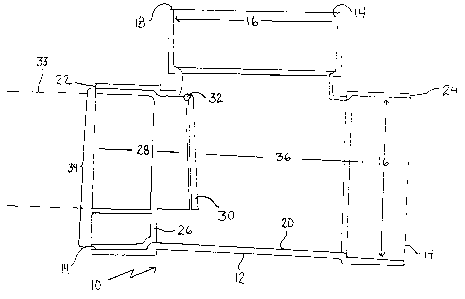Some of the information on this Web page has been provided by external sources. The Government of Canada is not responsible for the accuracy, reliability or currency of the information supplied by external sources. Users wishing to rely upon this information should consult directly with the source of the information. Content provided by external sources is not subject to official languages, privacy and accessibility requirements.
Any discrepancies in the text and image of the Claims and Abstract are due to differing posting times. Text of the Claims and Abstract are posted:
| (12) Patent: | (11) CA 2344321 |
|---|---|
| (54) English Title: | METHOD OF FABRICATING A BACKWATER VALVE |
| (54) French Title: | METHODE DE FABRICATION D'UN CLAPET ANTI-RETOUR |
| Status: | Term Expired - Post Grant Beyond Limit |
| (51) International Patent Classification (IPC): |
|
|---|---|
| (72) Inventors : |
|
| (73) Owners : |
|
| (71) Applicants : |
|
| (74) Agent: | NATHAN V. WOODRUFFWOODRUFF, NATHAN V. |
| (74) Associate agent: | |
| (45) Issued: | 2010-04-13 |
| (22) Filed Date: | 2001-04-18 |
| (41) Open to Public Inspection: | 2002-10-18 |
| Examination requested: | 2006-02-09 |
| Availability of licence: | N/A |
| Dedicated to the Public: | N/A |
| (25) Language of filing: | English |
| Patent Cooperation Treaty (PCT): | No |
|---|
| (30) Application Priority Data: | None |
|---|
A method of fabricating a backwater valve. A first step involves providing a fitting having at least two flow openings with an inner diameter. A second step involves providing an annular body having a central passage and a valve member movable between a closed position blocking the central passage and an open position. The annular body has an outer diameter adapted for close fitting insertion within the inner diameter of a selected one of the at least two flow openings. A third step involves inserting the annular body into the selected one of the at least two flow openings and securing the annular body in place.
L'invention concerne une méthode de fabrication d'un clapet anti-retour. La première étape consiste à prévoir un raccord ayant au moins deux orifices d'écoulement avec un diamètre intérieur. La deuxième étape consiste à prévoir un corps annulaire ayant un passage central et un élément de soupape amovible entre une position fermée bloquant le passage central et une position centrale. Le corps annulaire a un diamètre extérieur adapté à une insertion ajustée dans le diamètre intérieur d'une parmi au moins deux orifices d'écoulement. La troisième étape consiste à insérer le corps annulaire dans un des orifices d'écoulement et à maintenir le corps annulaire en place.
Note: Claims are shown in the official language in which they were submitted.
Note: Descriptions are shown in the official language in which they were submitted.

2024-08-01:As part of the Next Generation Patents (NGP) transition, the Canadian Patents Database (CPD) now contains a more detailed Event History, which replicates the Event Log of our new back-office solution.
Please note that "Inactive:" events refers to events no longer in use in our new back-office solution.
For a clearer understanding of the status of the application/patent presented on this page, the site Disclaimer , as well as the definitions for Patent , Event History , Maintenance Fee and Payment History should be consulted.
| Description | Date |
|---|---|
| Inactive: Expired (new Act pat) | 2021-04-19 |
| Inactive: COVID 19 - Deadline extended | 2020-03-29 |
| Common Representative Appointed | 2019-10-30 |
| Common Representative Appointed | 2019-10-30 |
| Inactive: Office letter | 2011-04-26 |
| Inactive: Office letter | 2011-04-26 |
| Grant by Issuance | 2010-04-13 |
| Inactive: Cover page published | 2010-04-12 |
| Pre-grant | 2010-01-13 |
| Inactive: Final fee received | 2010-01-13 |
| Notice of Allowance is Issued | 2009-09-18 |
| Letter Sent | 2009-09-18 |
| Notice of Allowance is Issued | 2009-09-18 |
| Inactive: Approved for allowance (AFA) | 2009-09-15 |
| Amendment Received - Voluntary Amendment | 2009-05-11 |
| Inactive: S.30(2) Rules - Examiner requisition | 2008-11-13 |
| Amendment Received - Voluntary Amendment | 2008-06-18 |
| Small Entity Declaration Request Received | 2008-04-02 |
| Small Entity Declaration Determined Compliant | 2008-04-02 |
| Appointment of Agent Requirements Determined Compliant | 2007-12-27 |
| Inactive: Office letter | 2007-12-27 |
| Revocation of Agent Requirements Determined Compliant | 2007-12-27 |
| Inactive: Office letter | 2007-12-18 |
| Inactive: S.30(2) Rules - Examiner requisition | 2007-12-18 |
| Appointment of Agent Request | 2007-11-16 |
| Revocation of Agent Request | 2007-11-16 |
| Amendment Received - Voluntary Amendment | 2006-04-03 |
| Letter Sent | 2006-02-23 |
| Request for Examination Received | 2006-02-09 |
| Request for Examination Requirements Determined Compliant | 2006-02-09 |
| All Requirements for Examination Determined Compliant | 2006-02-09 |
| Application Published (Open to Public Inspection) | 2002-10-18 |
| Inactive: Cover page published | 2002-10-17 |
| Inactive: First IPC assigned | 2001-07-12 |
| Application Received - Regular National | 2001-05-17 |
| Filing Requirements Determined Compliant | 2001-05-17 |
| Inactive: Filing certificate - No RFE (English) | 2001-05-17 |
There is no abandonment history.
The last payment was received on 2010-02-23
Note : If the full payment has not been received on or before the date indicated, a further fee may be required which may be one of the following
Please refer to the CIPO Patent Fees web page to see all current fee amounts.
Note: Records showing the ownership history in alphabetical order.
| Current Owners on Record |
|---|
| GABE COSCARELLA |
| Past Owners on Record |
|---|
| None |